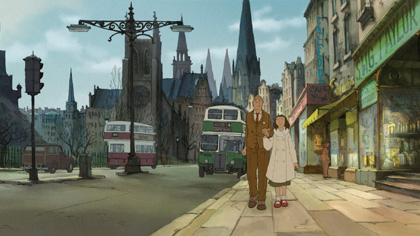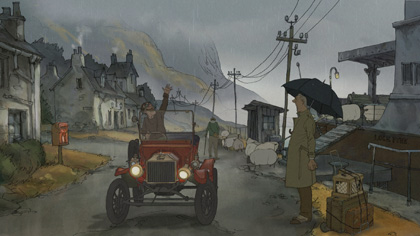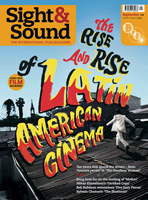Film of the Month: The Illusionist

An unproduced 1950s script by Jacques Tati proves the perfect match for Sylvain Chomet’s exquisitely melancholic animation style in ‘The Illusionist’, his follow-up to ‘Belleville Rendez-vous’. By Anton Bitel
Revered French film-maker and comic Jacques Tati died, aged 75, in 1982 – the same year that Sylvain Chomet finished high school. And yet there is a love for Tati in the animator’s work that transcends their generational differences – and even time itself. Chomet’s first short, La Vieille Dame et les pigeons (1998), paid homage to Tati’s Playtime (1967) by opening and closing with a chorus of crass American tourists in Paris; his debut feature Belleville Rendez-vous (Les Triplettes de Belleville, 2002) featured a poster for Tati’s Monsieur Hulot’s Holiday (Les Vacances de M. Hulot, 1953) prominent in the apartment of the titular triplets and showed them cackling away at a live-action excerpt from Tati’s Jour de fête (1949). Making free use of Tati’s trademark combination of nostalgic conservatism and clownish absurdity, Belleville acknowledged its debt to Tati’s ‘creative spirit’ in the end credits.
With his second feature The Illusionist, Chomet takes this love further. In a sequence towards the film’s end (and set in 1959), a hand-drawn figure who closely resembles Jacques Tati (and who even shares the director’s birth name, Tatischeff) ducks into an Edinburgh cinema. In the lobby a poster is clearly visible for Belleville Rendez-vous – even though this film was not to be made, or even conceived, until some four decades later. Tatischeff then enters the auditorium, where he is confronted with a live-action version of himself, as the real Tati is seen onscreen playing his alter ego Monsieur Hulot in Mon oncle (1958). Here, cinema is envisaged as a magical hall of mirrors in which Chomet can conjure an impossible dance across time and space between himself, the late director who has been his greatest inspiration, and their own respective filmic personae.
If The Illusionist feels like a film Tati might himself have conjured, that’s because it is closely adapted from a screenplay Tati himself wrote in the late 1950s, but then shelved for fear of the damage such a weighty piece might do to his carefully cultivated onscreen image. Instead he turned his attention to the less personal, altogether less bleak Hulot vehicle Playtime (1967), which Chomet slyly acknowledges in a scene where Tatischeff is shown holding a restaurant’s glass door open for a well-to-do couple, apparently about to reprise one of the most famous slapstick sequences from that film. The routine is interrupted when a voice on the soundtrack is heard to shout “Non, non!”, rejecting the chaotic slapstick of Playtime and pulling Chomet’s animation back on to the road not taken by Tati. In fact these two negatives comprise some of the only intelligible words spoken in a film that is, like all of Tati’s (and Chomet’s) films, virtually free of dialogue – although by no means silent. As in any Tati film, often the funniest comic business unfolds in the background or on the periphery, demanding that close attention be paid to the film’s rich visual texture in its panoramic entirety.
Chomet has shifted the principal location from Prague to Edinburgh (where The Illusionist was in fact also made, following Chomet’s decision, after presenting Belleville Rendez-vous at the Edinburgh Film Festival, to set up his Django studios in the city). The difference between this and other films by either Tati or Chomet can be measured in its (sometimes oppressively) realist setting, its darkly elegiac tone and an approach to nostalgia that is more bitter than sweet. Tatischeff is an ageing Parisian vaudeville magician in the era of rock ’n’ roll, always moving from place to place in search of an audience that still appreciates his démodé brand of performance. Both in London and ultimately in Edinburgh, he is upstaged by new band Billy Boy and the Britoons; he also has the misfortune to bring his act to an isolated pub on an island off the west coast of Scotland on the very same day that electricity first arrives, so that both he and a local band of traditional musicians are replaced almost overnight by a new jukebox blaring dance music (no doubt also by the Britoons).

The light we see switched on in the pub for the first time will be echoed at the film’s close, as the light to Tatischeff’s Edinburgh room is switched off for the last time, marking the end both of his Scottish tour, and of an era. Our illusionist will not triumph, like Hulot, against encroaching modernity, but resign himself grimly to his own obsolescence, eventually putting all he loves behind him and setting off on the road one more time. His naive ward Alice, meanwhile, will slowly be transformed – in one of Tatischeff’s most effective (and least affordable) illusions – from provincial ingénue to elegant lady about town, failing to recognise what she has lost until it is gone. The last gift Tatischeff will grant her is, precisely, her disillusionment, marking both her final coming of age and his own surrender to it. It is an act of betrayal (and self-betrayal) that will leave few dry eyes in the cinema.
Tatischeff and Alice are joined in their tragicomic adventures by a hilariously disgruntled stage rabbit, a perpetually drunken Scotsman and a whole troupe of similarly desperate performers (the alcoholic ventriloquist, the suicidal clown – only the younger acrobats display the levity that matches their calling). But the real tritagonist here is time itself. Ever behind the times, Tatischeff is repeatedly delayed from his London stage debut by the extended encores of the trendier act on before him; he struggles to operate newfangled car-washing equipment to a clock’s audible tick-tick-ticking; and he fails to be properly woken by his alarm clock in time for a new gig with an advertising firm. Meanwhile Alice, determined to make up for time lost back in her Hebridean home, first meets her future beau in an upmarket Edinburgh store, browsing clocks and watches.
‘Out with the old and in with the new’ seems to be Chomet’s melancholic theme here – a theme that’s reinforced visually by the merger of exquisite ‘old-fashioned’ hand-drawn 2D characters and digitally created 3D props and backgrounds. It looks absolutely beautiful; and while Tatischeff and Alice may both end up disenchanted, Chomet paints in plenty of subtle optical trickery to keep viewers, at least, believing in magic. Wind-blown feathers are mistaken for snow. ‘Little’ Joe, the owner of the Edinburgh hotel for artistes where Tatischeff and Alice take up residence, turns out not to be seated behind the counter, but just very short. Two headlights rushing out of the darkness at Alice in fact belong not to an oncoming truck, but to a pair of police motorbikes. As a book’s pages flutter in the breeze, its shadow on the wall assumes the form of a flapping bird. In this world of fleeting phenomena, Chomet himself proves to be the ultimate illusionist.
Charting the shifting relationship between an older man and a younger woman, Tati’s original script may also have been a love letter to his daughter Sophie Tatischeff. Four decades after it was written, Sophie mentioned her late father’s unproduced script to Chomet when he approached the Tati estate for permission to use an extract from Jour de fête in Belleville Rendez-vous. Sophie died before The Illusionist went into production, but the heartfelt letter has at last been delivered, preserving in its images the memory of Tati père et fille. Magicians may not exist, but Chomet has managed to bring the dead to life.
Sylvain Chomet talks about how he came to realise Tati’s unfilmed script on page 45 of the September 2010 issue of ‘Sight & Sound’
See also
An animated crowd: Isabella Kaminski reports on the 2010 Annecy Animation Festival (online, April 2010)
Me and Joseph Brodsky: Nick Bradshaw talks to Russian animator Andrey Khrzhanovsky about his Joseph Brodsky memoir Room and a Half (online, May 2010)
Best of herd: Nick Bradshaw previews the 2010 British Animation Awards (online, February 2010)
Animation: timeline from trick effects to CGI (August 2006)
Castles in the sky: Andrew Osmond on Howl’s Moving Castle (October 2005)



